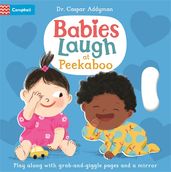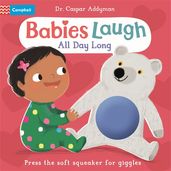How to make babies laugh: tips from Dr Caspar Addyman
Developmental psychologist and children's book author, Dr Caspar Addyman, on how to get your little-ones giggling.

For the last two decades, I have studied how babies learn. Thirteen years ago my brother, Max, was starting out as a stand-up comedian and my sister had just had her second baby. “Eureka!” I thought. Max could make the baby laugh and I could explain what they found funny. The idea was planted and I embarked on a decade researching why babies laugh.
Babies are born to laugh! It is one of their best tricks for getting and holding an adult’s attention – a charming counterpoint to baby tears. Babies spend a long time helpless and speechless, but laughter and tears let them communicate. Crying tells us something is wrong and invites us to fix it. Laughter tells us they find something delightful and invites us to keep it going if we can. And usually we can, because the thing that makes babies laugh more than anything else is human connection.
The best ways to make babies laugh
The best way to make a baby laugh is simply to take them seriously. Stop what you are doing and pay attention to what they are doing. Take an interest in what they are interested in and let them lead the interaction. The baby will be delighted and their laughter will let you know.
When I surveyed 1400 parents all over the world, there were so many things that made their babies laugh: people, pets, puppets, toys, tastes, tunes. But two things stood out: peekaboo and tickles. Peekaboo is universally popular and it illustrates that secret of baby laughter: it’s all about attention and connection. Peekaboo is a conversation where the baby is an equal partner. They are delighted because it is a game where they are an active player and it helps them learn about that biggest mystery in the world – other people. My first book in the Babies Laugh series, Babies Laugh at Peekaboo celebrates and encourages just this.
Babies Laugh at Peekaboo
by Dr Caspar Addyman
Babies will love opening the pages to reveal smiling, giggling and laughing baby faces, beautifully illustrated by Ania Simeone. The shiny mirror at the back of the book is perfect for entertaining babies up to 18 months old.
Should we tickle babies?
Tickling is more mysterious. Scientists don’t know for certain why it makes us laugh. Our skin is sensitive to ticklish sensations as a protection against parasites. But tickling itself more likely evolved as a form of social play. Baby chimps, for example, actively seek out tickle play and baby rats not only like being tickled but it even seems to make them laugh.
However, around half of adults dislike being tickled. This leads a few people to argue against tickling babies because we can’t assume they enjoy it. I disagree. Babies have some very effective ways of letting us know if they dislike things, and parents know better than anyone how to respond to their children.. So I trust their judgement,with the caveat that consent matters. Babies need to be invited to play the game and it should start and stop on their terms. When creating Babies Laugh at Tickles, we built this into the book with a button that babies can “Press for Tickles”. For similar reasons, don’t let young children play tickle games with babies unless closely supervised.
Babies Laugh at Tickles
by Dr Caspar Addyman
Play along together and get little ones giggling with Babies Laugh at Tickles, a joyful board book with a giant sound button and an interactive tickle game. Babies will love joining in with the story, as you are prompted to tickle them from their toes . . . to their nose!
When do babies start laughing?
When I surveyed parents, first laughs happened on average at around three and a half months. But it is important to note that every baby is different – it could happen as early as a few weeks old, all the way up to ten months. Amazingly, researchers at Durham University have even reported babies “practising” laughter in the womb.
The Navajo people understand the importance of baby laughter and its power to connect us. The Navajo are a Native American tribe from the Southwest United States. In their culture a baby’s first laugh is an intentional and social act that marks the baby’s choice to become one of the ‘Earth people’. It is a great honour to be the person who makes the baby laugh. They and the baby are joint hosts at a laughter party to welcome the baby into the community, with these parties typically happening when the child is three or four months old.
In short, enjoy the ride . . .
In twenty years as a baby researcher, including publishing my non-fiction book The Laughing Baby, I have met a lot of babies and their parents. Those first few years are by no means easy. Babies have their ups and downs. The world is a wonderful but overwhelming place and the transition from laughter to tears and back to laughter can happen many times a day. The bond with parents provides the safety to let babies learn and explore these feelings.
Being a parent is often overwhelming too. It is a full-time job with huge responsibilities where you are on call 24-7. And, as more than one exhausted visitor to my lab has observed, “if you didn’t laugh you’d cry”. This reminds us just how important those shared moments can be. Babies laugh to let us know they are loving life and want to share it with us. Baby laughter is serious business.
Babies Laugh at Everything
by Dr Caspar Addyman
This joyful book is brimming with relatable scenes of family life in every shape and size - from funny mummies and happy daddies to silly siblings and giggly grannies! – and the bouncy rhyme is full of repetition to help with early language acquisition.
Babies Laugh All Day Long
by Dr Caspar Addyman
With bouncy read-aloud words and adorable illustrations of laughing, smiling babies, little ones will love going through the five familiar daily moments together – nappy time, dinner time, play time and bath time, ending with a cosy bedtime scene!






